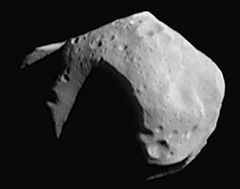(253) Mathilde
|
Asteroid (253) Mathilde |
|
|---|---|

|
|
| Asteroid Mathilde with its largest crater Karoo in the foreground ( NEAR , 1997) | |
| Properties of the orbit ( animation ) | |
| Orbit type | Main belt asteroid |
| Major semi-axis | 2,651 AU |
| eccentricity | 0.263 |
| Perihelion - aphelion | 1.953 AU - 3.348 AU |
| Inclination of the orbit plane | 6.7408 ° |
| Length of the ascending node | 179.5798 ° |
| Argument of the periapsis | 157.4923 ° |
| Time of passage of the perihelion | November 8, 2018 |
| Sidereal period | 4 a 111 d |
| Mean orbital velocity | 18.0 km / s |
| Physical Properties | |
| Medium diameter | 66 × 48 × 46 km |
| Dimensions | 1.033 x 10 17 kg |
| Albedo | 0.0436 (± 0.004) |
| Medium density | 1.3 g / cm³ |
| Rotation period | (17.406 ± 0.010) d |
| Absolute brightness | 10.3 mag |
| Spectral class | Cb (SMASS classification) |
| history | |
| Explorer | Johann Palisa |
| Date of discovery | November 12, 1885 |
| Another name | 1949 OL 1 , A195 TN |
| Source: Unless otherwise stated, the data comes from JPL Small-Body Database Browser . The affiliation to an asteroid family is automatically determined from the AstDyS-2 database . Please also note the note on asteroid items. | |
(253) Mathilde is an asteroid in the main asteroid belt with a mean diameter of about 53 km. In June 1997 the NEAR -Shoemaker space probe flew past Mathilde at a distance of 2,400 km and sent photographic images to Earth.
description
Mathilde's surface is very dark, blacker than coal . The asteroid belongs to the spectral class Cb in the SMASS classification and is likely to be chemically similar to the carbonaceous chondrites , a group of carbonaceous stone meteorites . Mathilde orbits the sun on an eccentric orbit that reaches the outermost part of the asteroid belt. It rotates slowly around its own axis and has one of the longest periods of rotation of the known asteroids. The main feature of Mathilde's surface is a huge impact crater 10 km deep. The fact that Mathilde in this impact event was not destroyed, suggests that the asteroid is not a compact body, but an accumulation of debris pieces ( rubble pile ) by the weak gravity are held together. This is also indicated by the low density of 1.3 g / cm 3 , which could be determined from the path deflection of the probe.
It is believed that (253) Mathilde was named after the wife of the astronomer Maurice Loewy .
See also
Web links
Individual evidence
- ↑ Kevin R. Housen, Keith A. Holsapple, Michael E. Voss: Compaction as the origin of the unusual craters on the Asteroid Mathilde. ( Memento of September 1, 2006 in the Internet Archive ) In: Nature, Vol. 402, November 11, 1999, p. 156